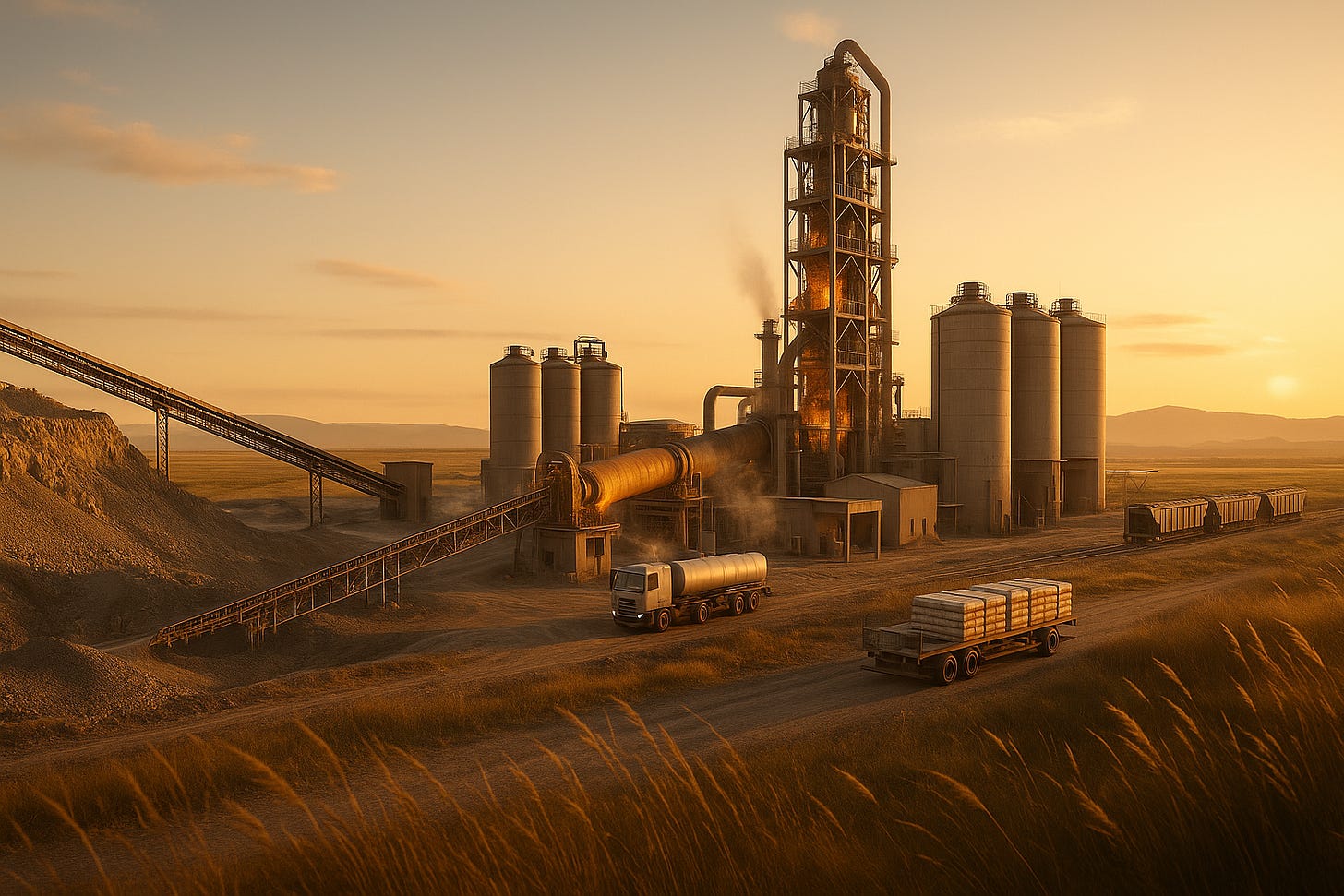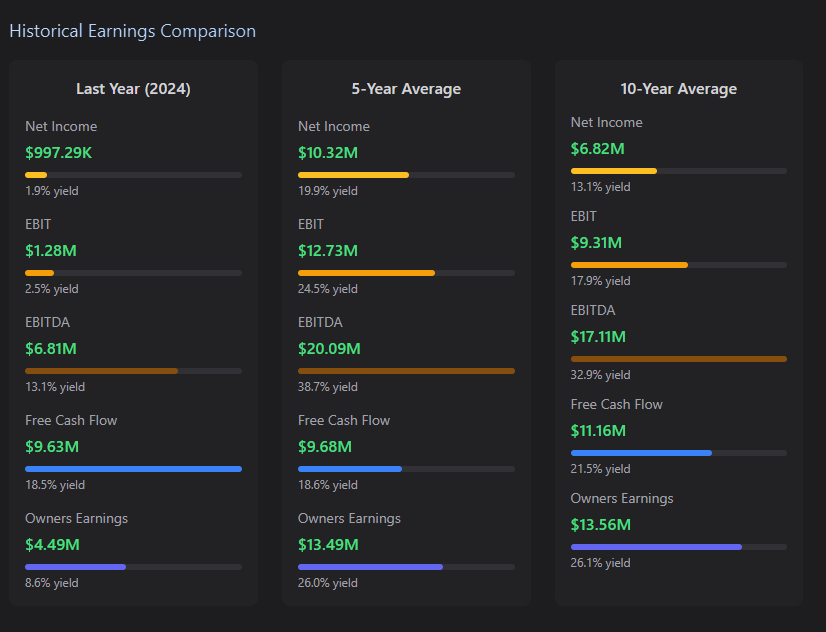A Boring Business Paying 15% Dividends
Also trading at liquidation value and just 5x the 5Y average FCF.
Today’s stock is attached to a very boring business.
This sounds like a bad thing, but to a deep-value investor, boring is good.
Boring is simple and relaxing.
Boring is a relief from the crazy shenanigans of shady management teams, melting ice cubes, companies in structural decline, and business-models that evaporate overnight.
Boring means business-valuations that provide conviction.
You just know it’s still going to be trundling along, for the next decade, doing its thing.
The only question in these scenarios is:
“Is it cheap enough?”
Here are the ratios:
NCAV Ratio = 4.7
TBV Ratio = 0.9
EV/5Y FCF Ratio = 5
P/5Y FCF Ratio = 5.5
It’s not a net-net but the positive NCAV does indicate a healthy, cash-rich business with a rock solid balance sheet.
It’s trading around liquidation value, which implies the operating business is worth virtually nothing to the market.
And, if you bought the business at today’s price, you’d have your money back, from earnings alone in about 5 years.
The core business has been operating since 1953.
And, let’s not forget those dividends.
*Last year indicates a buyback, but it was actually a capital repayment, which is kind of similar to a dividend.
Based on net-cash and earnings over the last few years, the business is trading with around 50% upside to its fair value price (calcs explained in this post).
This in itself isn’t exactly exciting, but making money consistently never is.
Let’s dive in…
The Business
Steppe Cement (STCM) is a single-site cement producer in Kazakhstan. It’s headquartered in Malaysia (Labuan) and listed in London (AIM).
It sells bagged and bulk cement into the regional domestic markets.
In other words, they mine the raw materials, make this into ‘clinker’ (small balls of rock), grind that clinker into a soft powder (cement) and then sell it to the local building market.
Here’s an interesting fact in a desperate attempt to make cement more interesting:
Cement is a key ingredient in the most consumed substance on earth (after water), concrete.
So, as boring as it may be, demand for their product is going to be pretty solid, forever.
Steppe makes money on volume.
The more cement it can sell, the more money it makes.
The margin comes from the production costs (energy) and logistical efficiency (shorter routes to the customer).
The lower the costs, the more money it makes.
The main strategy of the business is to be reliable while keeping capex low and targeted.
They also focus on selling via the shortest routes possible (to protect those margins), keeping lots of cash in the bank, and, my favourite, returning cash to shareholders ASAP.
The board has been very shareholder friendly to date, often paying dividends, and even applying to conduct capital repayments when dividends were not efficient.
57% of the company is in ‘private’ hands.
This ownership stake is split between three unrelated but collaborative shareholders; Tan Sri Azmi bin Wan Hamzah (31%), Javier Del Ser Perez (9%), and David Crichton-Watt (17%).
These guys have all been involved with Steppe since the days of the IPO, and have frequently popped up over the years to help underwrite the business and acquire more stock.
Javier is the current CEO and Wan Azmi used to be the chairman. He’s no longer involved in the management, but his son sits on the board.
Digging into their ownership history gives the impression of owners that value their business, and have a long-term view.
This is a very natural explanation about why the company is so friendly to shareholders, in general.
Why It’s Cheap
This really is a pretty boring business.
There’s not much growth potential because, well, it sells Cement, in Kazakhstan.
They do export (Russia and Kyrgyzstan) , but the latest update mentioned that some of those exports (Uzbekistan) have basically stopped due to over-supply.
Not only this, but they don’t have much pricing power.
Over recent years, competition has entered the market and rail-costs have increased. These are cyclical things, but they still compress margins in the short term.
Things also look worse than they really are, due to FX rate fluctuations.
The company generates sales in KZT, but reports everything in USD.
For example, in Q325, the business reported +21% YoY revenue growth, and the 9-month growth was +28%.
They also generated an all time record clinker production volume, during those 9 months.
However, because the local currency lost 13% of its value over the same period, the improvements didn’t look like improvements at all.
These ‘headline’ results, further depressed the stock price.
Another thing weighing on the price over the past few years (since 2016) was an unresolved tax dispute.
This generated uncertainty which the market hates, but has since been fully resolved with no impact on the business.
When you put all of these things together, the stock looks like a bit of an ‘ugly duckling’.
The price has reflected that, down from a 5-year high of £0.61 to just £0.18 today.
Nothing terrible has happened, and the business trundles along, while the stock price gets forced lower and lower, by lack of interest.
The Risks
The biggest risk to Steppe is cheaper cement arriving from abroad, and a brand new competing plant that recently went live.
This puts further pressure on an already weak pricing power. Even as demand rises locally, they need to be careful about increasing prices too much.
To counteract this, management has refocused on northern markets (closer to their base), where transport is much cheaper (trucks instead of rail).
This is kind of an advantage against those new competitors, because to penetrate this region they themselves must absorb more transport costs.
The second risk is that of general transport and energy costs. These things have risen globally since the pandemic / Russia invasion.
Aside from transporting their product more efficiently, management have also focused Capex on reliability and efficiency rather than trying to expand or outbid rivals.
The export situation is also troubling. These increased costs plus an oversupply in neighbouring markets has pressured margins further.
The final risk to the business is in the FX fluctuations.
This is mostly optical though. The conversion to USD figures can make underlying performance look misleadingly weak.
The bottom line is that all these so-called risks are related to market cycles or standard cost-spread risks that any business must face.
Nothing here points to anything like the terminal or structural decline of a very healthy, cash-rich business.
The only risk that I see here is in the size of the free float.
This is a risk to minority shareholders.
To us.
It’s impossible for any outside activist to build up a large enough stake to change the course of the business.
This leaves all the power concentrated in the hands of the current majority owners.
If the stock price continued falling, and the cash continued stacking up on the balance sheet, why not delist the business and take it fully private?
Why not use the company cash to buy out all the minority shareholders at a ridiculously low price?
Why not use the cash in the business to inflate your own ownership of the business and increase the future-dividends you receive?
Why not, indeed.
The only thing stopping the majority owners doing this is, morals or ethics, or maybe they just haven’t thought if it yet.
It’s certainly worth noting that a delisting could occur with 75% of votes cast (rather than total shares), and there are virtually none of the UK takeover protections here because it’s based in Malaysia.
This risk is real.
Steppe is cheap, but that doesn’t mean we can make money, even at today’s price. In fact, this risk, arguably, increases as the stock becomes cheaper.
A lesson of that happening is here.
The Investment Case
Steppe Cement is a healthy, cash-flowing, cash-rich business with a very shareholder friendly approach.
It’s earnings are solid and quite reliable.
Despite their control, the majority owners seem fair-minded and aligned with all shareholders.
The business makes a great effort to pay dividends whenever possible and even resorted to a capital repayment when dividends were not the best option.
The latest Q325 update clearly states that the business has been stacking cash, and now has $14m, instead of the $7m in the most recent accounts.
They also specifically mentioned that they are planning to return some of this to owners as soon as is practical.
If this continues, the dividend yield, at today’s price is around 15% per year.
Maybe more.
The Q325 update indicated that revenues and volumes were up (record high clinker production too).
Cement demand, in general, isn’t going away anytime soon.
Steppe has been serving this market since the 50’s (albeit in different guises).
All of this points to the business carrying on for the foreseeable future and rewarding its owners with nice, regular pay-outs.
Aside from the risk of owner-concentration, the only question is whether or not it’s cheap enough at the current price.
Of course, that’s a decision for each individual investor to answer for themselves, but for me, it’s not quite cheap enough, yet.
If I do decide to buy some stock in the future, there will, as ever, be a full write up to update.



